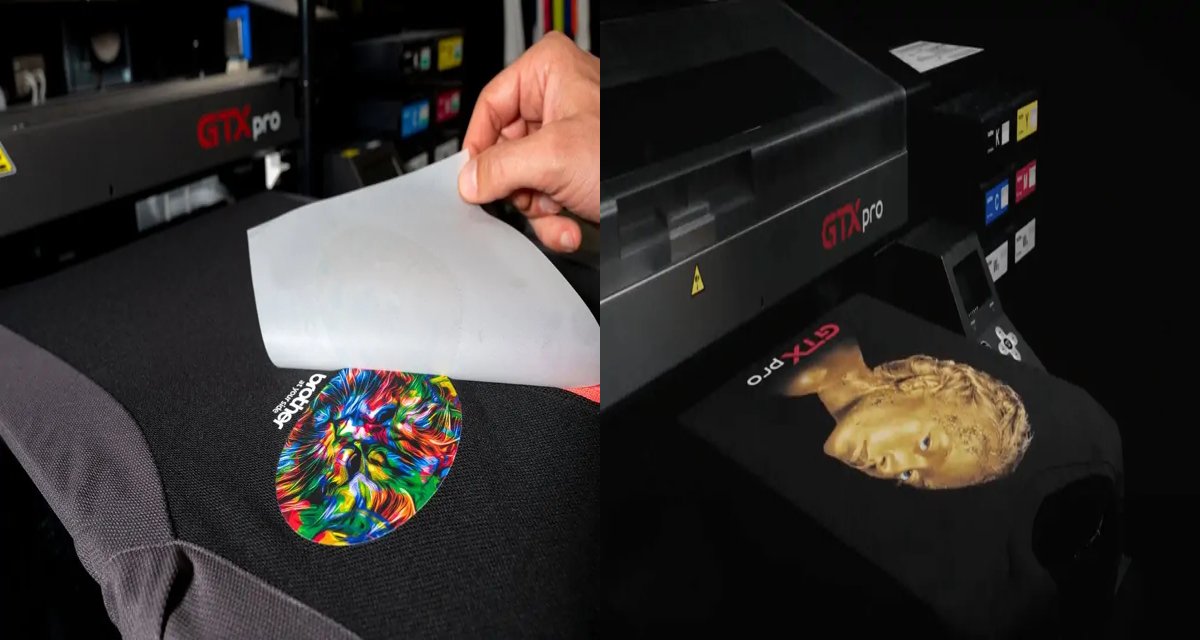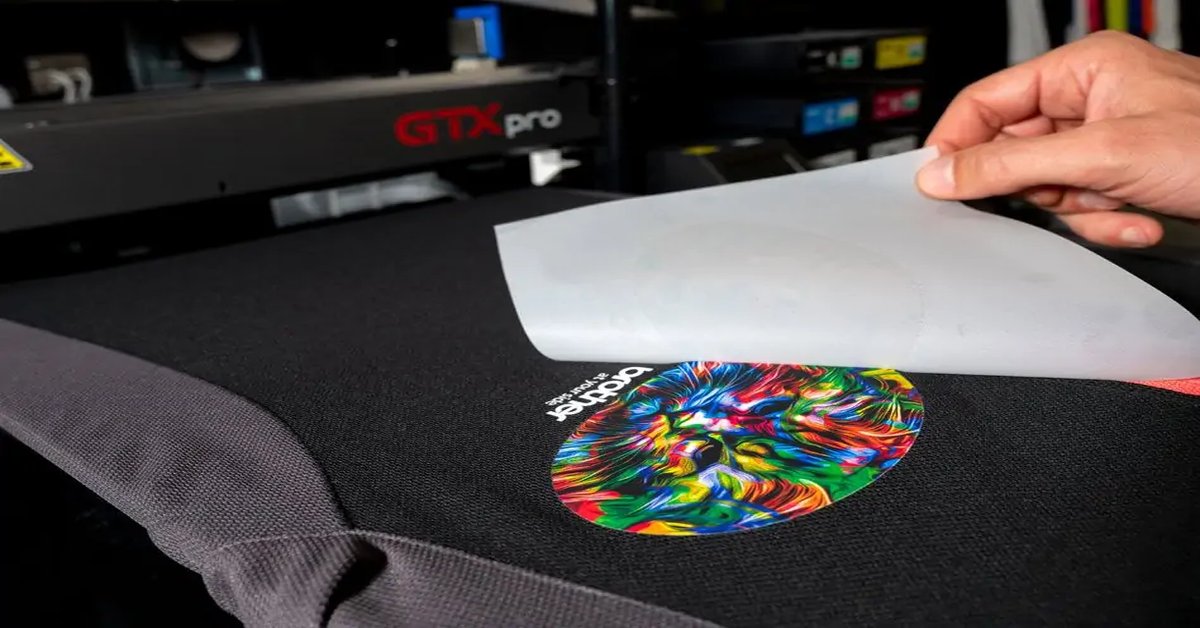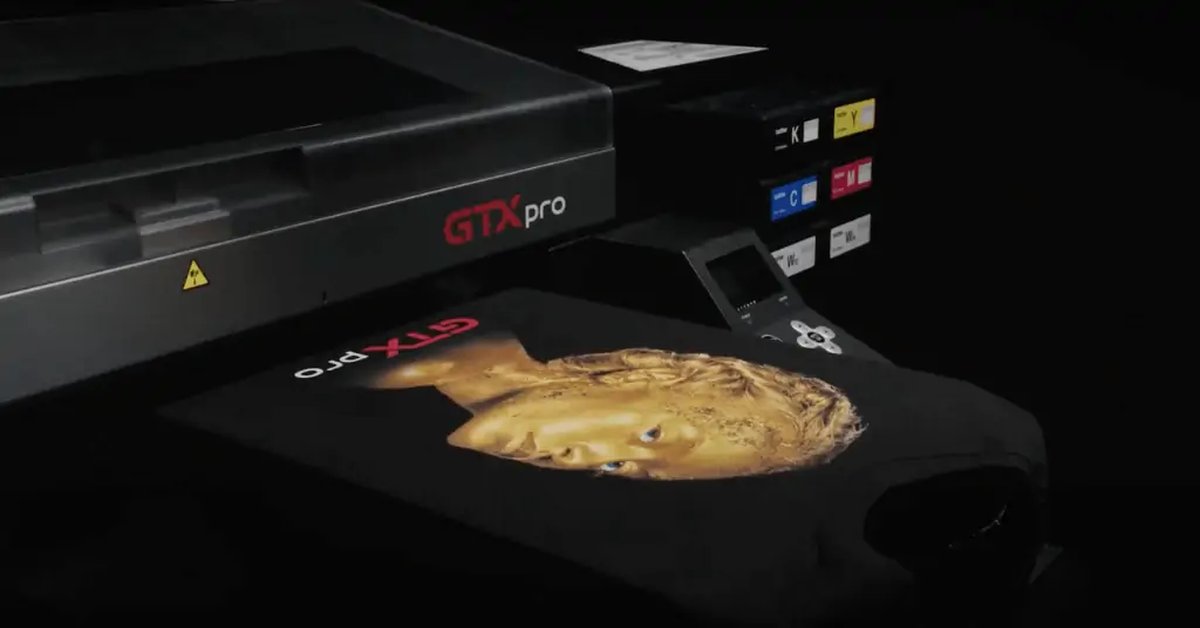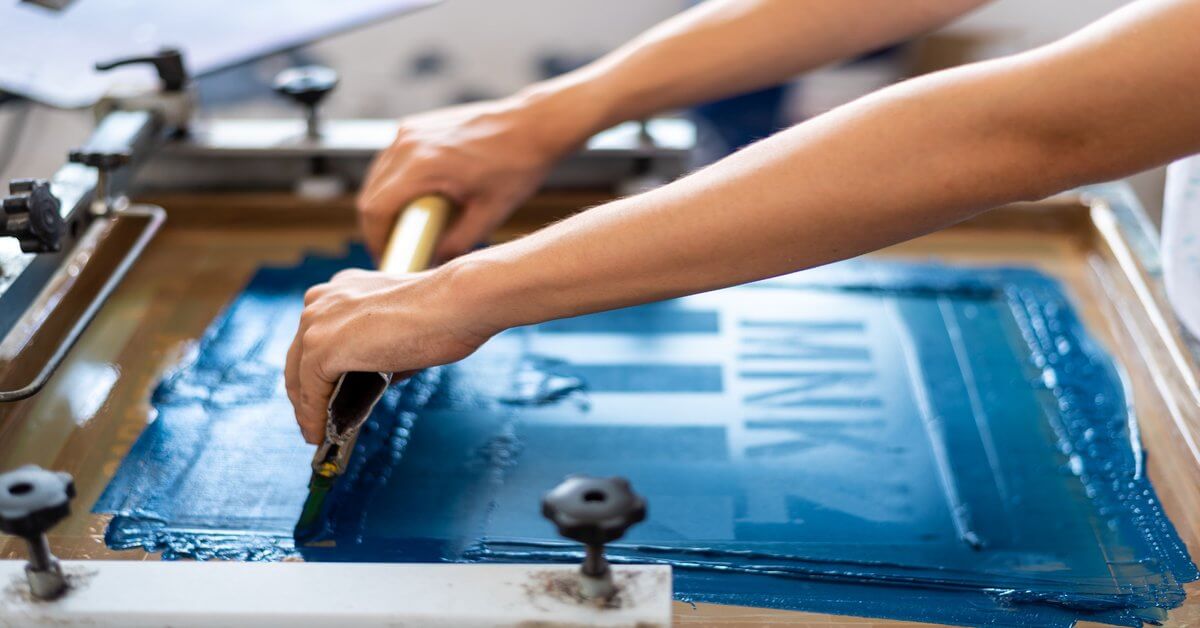Direct-to-Garment (DTG) vs. Direct-to-Film (DTF) vs. Heat Transfers: A Comprehensive Guide
When it comes to custom apparel printing, there are several printing techniques to choose from, each with its own strengths, limitations, and best-use scenarios. Direct-to-Garment (DTG), Direct-to-Film (DTF), and Heat Transfers are three of the most popular methods used for creating custom t-shirts, hoodies, and other fabric products. Each technique offers unique advantages, whether you’re looking for full-color prints, fast production times, or versatility across various materials.
In this comprehensive guide, we’ll dive deep into the key differences between Direct-to-Garment (DTG), Direct-to-Film (DTF), and Heat Transfers. We will explore their printing processes, pros and cons, costs, and best use cases to help you determine which method is best for your custom apparel needs.
Table of Contents:
- What is Direct-to-Garment (DTG) Printing?
- What is Direct-to-Film (DTF) Printing?
- What are Heat Transfers?
- Key Differences Between DTG, DTF, and Heat Transfers
- Advantages of Direct-to-Garment (DTG) Printing
- Advantages of Direct-to-Film (DTF) Printing
- Advantages of Heat Transfers
- Disadvantages of DTG, DTF, and Heat Transfers
- Best Practices for DTG, DTF, and Heat Transfers
- Choosing Between DTG, DTF, and Heat Transfers: When to Use Each Method
- Cost Comparison: DTG vs. DTF vs. Heat Transfers
- Durability and Quality: How DTG, DTF, and Heat Transfers Compare
- Environmental Impact: DTG vs. DTF vs. Heat Transfers
- Future Trends in DTG, DTF, and Heat Transfers
- Conclusion: Which Printing Method is Right for You?
1. What is Direct-to-Garment (DTG) Printing?
Direct-to-Garment (DTG) is a digital printing technique that uses inkjet technology to apply water-based inks directly onto fabric. This method allows for highly detailed, full-color designs to be printed with high resolution, making it ideal for complex graphics, photographs, and designs that involve multiple colors or gradients.
The DTG process is fairly straightforward:
- A digital image is created using graphic design software.
- The garment (typically 100% cotton or a cotton blend) is pre-treated to ensure the ink adheres properly.
- The garment is loaded into the DTG printer, and the design is printed directly onto the fabric.
- The ink is cured using a heat press or conveyor dryer, which ensures the design bonds with the fibers of the fabric.
DTG is particularly well-suited for one-off custom garments or short runs, as there is no need for setup (such as screens or stencils), and designs can be printed on demand.
2. What is Direct-to-Film (DTF) Printing?
Direct-to-Film (DTF) is a newer printing technique that involves printing designs onto a special PET film, which is then transferred to fabric using heat and adhesive powder. Unlike DTG, which prints directly onto the fabric, DTF allows for greater versatility as the design is transferred from the film onto a variety of fabric types, including cotton, polyester, blends, and even non-textile materials.
The DTF process works as follows:
- The design is printed onto PET film using a DTF printer, which utilizes specialized pigment inks.
- A powdered adhesive is applied to the printed design on the film.
- The design is then cured with heat, solidifying the ink and adhesive on the film.
- The design is transferred from the film onto the fabric using a heat press, bonding the ink and adhesive to the fabric fibers.
DTF is known for its vibrant colors and ability to work on a wide range of materials, making it a versatile option for businesses or individuals who want to print on fabrics that might not work well with DTG.
3. What are Heat Transfers?
Heat Transfers involve applying pre-printed designs onto garments using heat and pressure. Heat transfer designs are printed onto a special transfer paper using inkjet or laser printers, or they can be cut from vinyl using a cutting machine. The design is then transferred onto the fabric using a heat press, which activates the adhesive and bonds the design to the fabric.
There are a few different types of heat transfers:
-
Heat Transfer Vinyl (HTV): A vinyl material is cut into a design using a plotter or cutting machine, and then heat-pressed onto the fabric. HTV is often used for simple designs, logos, or lettering.
-
Inkjet/Laser Heat Transfers: The design is printed onto heat transfer paper using a regular printer and then transferred onto the garment.
-
Sublimation Heat Transfers: Sublimation printing uses heat to transfer dye into the fabric, resulting in a long-lasting and vibrant design. Sublimation works best on polyester fabrics or sublimation-coated items.
Heat transfers are often used for smaller projects, DIY custom apparel, and one-off designs, offering a fast and accessible way to create custom garments without investing in expensive equipment.
4. Key Differences Between DTG, DTF, and Heat Transfers
Though all three methods—DTG, DTF, and heat transfers—are used to print custom designs onto fabric, they differ significantly in terms of process, fabric compatibility, cost, and durability. Here are the key differences:
1. Printing Process
-
DTG: Prints directly onto the fabric using inkjet technology and water-based inks. Requires fabric pre-treatment.
-
DTF: Prints the design onto a film, which is then transferred to the fabric using heat and adhesive.
-
Heat Transfers: Transfers pre-printed designs onto fabric using heat and pressure. Can involve vinyl cutting, inkjet/laser printing, or sublimation.
2. Fabric Compatibility
-
DTG: Works best on 100% cotton fabrics but can be used on cotton-blend materials.
-
DTF: Compatible with a wide range of fabrics, including cotton, polyester, blends, and even non-textile materials.
-
Heat Transfers: Depends on the type of transfer. HTV works on most fabrics, while sublimation requires polyester or coated materials.
3. Color and Design Complexity
-
DTG: Capable of producing highly detailed, full-color designs with gradients and shading. Ideal for photorealistic images.
-
DTF: Produces vibrant, full-color designs with good detail. Works well on dark and light fabrics.
-
Heat Transfers: HTV is limited to solid colors, while inkjet/laser transfers can produce full-color designs but may lack durability.
4. Durability
-
DTG: Prints can fade or crack over time, especially if not properly cared for. Best durability on light fabrics.
-
DTF: Highly durable, resistant to fading, cracking, or peeling. Performs well on both dark and light fabrics.
-
Heat Transfers: Durability varies based on the type. HTV is durable but can peel over time, while inkjet/laser transfers may fade or crack after multiple washes.
5. Setup and Speed
-
DTG: Minimal setup time, but slower printing speeds for large batches.
-
DTF: Requires more setup (printing onto film and applying adhesive), but faster than DTG for large batches.
-
Heat Transfers: Fast setup, especially for HTV, but can be slower for intricate designs requiring weeding.
6. Cost
-
DTG: Higher initial investment in the printer and consumables, but cost-effective for short runs.
-
DTF: Moderate setup cost, with versatility across multiple fabrics making it cost-effective for mid-sized runs.
-
Heat Transfers: Low setup cost but higher labor cost for weeding and transferring, especially for HTV.
5. Advantages of Direct-to-Garment (DTG) Printing
1. Full-Color, High-Resolution Prints
DTG printing excels in producing detailed, high-resolution prints with complex color gradients, shading, and even photorealistic images. This makes it ideal for designs with many colors or intricate details that would be difficult to achieve with other methods.
2. Quick Setup for Small Orders
Since DTG doesn’t require screens or plates, it has minimal setup time, making it perfect for small batches or one-off custom designs. You can easily print on demand, without worrying about minimum order quantities.
3. Soft, Comfortable Feel
Because DTG inks are absorbed into the fabric, the print feels soft and doesn’t add any significant texture or weight to the garment. This makes DTG-printed garments more comfortable to wear, especially for lightweight apparel like t-shirts.
4. Eco-Friendly Inks
DTG uses water-based inks, which are generally more environmentally friendly than other types of inks, such as plastisol (used in screen printing). This reduces the environmental impact of the printing process.
6. Advantages of Direct-to-Film (DTF) Printing
1. Versatility Across Fabrics
One of the biggest advantages of DTF is its ability to print on a wide range of fabrics, including cotton, polyester, blends, and even synthetic materials. This makes DTF an ideal choice for businesses that want to print on various garment types or non-textile surfaces.
2. No Pre-Treatment Required
Unlike DTG, DTF does not require pre-treatment of the fabric before printing. This simplifies the process and reduces production time, especially when working with dark fabrics or non-cotton materials.
3. Durable Prints
DTF prints are known for their durability. They are resistant to fading, cracking, or peeling, even after repeated washes. This makes DTF a reliable option for garments that will undergo frequent wear and washing.
4. Cost-Effective for Large and Small Runs
DTF offers a balance between DTG and screen printing in terms of cost-effectiveness. It’s suitable for both small and large production runs, offering flexibility in terms of order size without compromising quality.
7. Advantages of Heat Transfers
1. Affordable Setup
Heat transfers, particularly HTV, have a low setup cost, making them accessible to hobbyists and small businesses. All you need is a cutting machine, heat press, and transfer material, which are relatively inexpensive compared to DTG or DTF equipment.
2. Fast Production for Simple Designs
HTV is great for simple designs, logos, or text, and the setup time is minimal. Once the design is cut and weeded, it can be transferred quickly using a heat press. This makes it a fast and efficient option for producing custom apparel with basic designs.
3. Wide Range of Specialty Materials
Heat transfers, especially HTV, offer a wide range of specialty finishes, including glitter, metallic, holographic, and even reflective vinyl. This allows for creative and eye-catching designs that aren’t possible with DTG or DTF.
4. Ideal for DIY and Personalization
Heat transfers are a popular choice for DIY projects and personalization, as they don’t require advanced equipment or technical skills. This makes them a great option for crafters, hobbyists, or small businesses looking to offer custom apparel.
8. Disadvantages of DTG, DTF, and Heat Transfers
While each method has its benefits, there are also limitations to consider:
DTG Printing
-
Fabric Limitations: Works best on 100% cotton or high-cotton-content fabrics, and may not perform as well on polyester or synthetic materials.
-
Slower Production Speed: DTG printing can be slower for large runs, making it less ideal for bulk production.
-
Pre-Treatment Required: DTG requires pre-treatment of dark fabrics to ensure proper ink adhesion, which adds time and complexity to the process.
DTF Printing
-
Additional Steps: DTF requires printing onto film and applying adhesive powder before transferring the design, which adds extra steps compared to DTG.
-
Limited Availability: DTF is a newer technology, and specialized equipment and materials may not be as widely available as DTG or heat transfers.
Heat Transfers
-
Durability Issues: Heat transfers, especially inkjet or laser-printed transfers, may not be as durable as DTG or DTF prints. HTV can also peel over time, especially with repeated washing.
-
Weeding Complexity: For intricate designs, weeding HTV can be time-consuming and difficult, making it less efficient for detailed artwork.
9. Best Practices for DTG, DTF, and Heat Transfers
To get the best results from each printing method, follow these best practices:
DTG Printing
-
Use High-Resolution Artwork: Ensure your designs are at least 300 DPI to achieve crisp, clear prints.
-
Pre-Treat Dark Fabrics: Always apply a pre-treatment solution to dark fabrics to ensure vibrant, durable prints.
-
Cure the Ink Properly: Use a heat press or conveyor dryer to cure the ink at the recommended temperature and time.
DTF Printing
-
Apply Adhesive Evenly: Make sure the adhesive powder is evenly distributed on the printed film to avoid patchy transfers.
-
Cure the Design Properly: Ensure the design is properly cured on the film before transferring it to the garment.
-
Choose the Right Heat Settings: Use the appropriate heat and pressure settings when transferring the design to avoid scorching the fabric or damaging the print.
Heat Transfers
-
Use the Right Vinyl for the Job: Select the appropriate type of vinyl for your project, whether it’s regular HTV, glitter, or metallic vinyl.
-
Test Your Press Settings: Always run test presses to ensure your heat and pressure settings are correct for the fabric and vinyl.
-
Weed Designs Carefully: For detailed designs, take your time weeding to avoid tearing or damaging the vinyl.
10. Choosing Between DTG, DTF, and Heat Transfers: When to Use Each Method
When deciding which printing method to use, consider the following factors:
Choose DTG If:
- You need full-color, detailed prints with gradients or photorealistic images.
- You’re printing on cotton garments or lightweight apparel.
- You need one-off custom designs or small batch orders.
Choose DTF If:
- You need to print on a variety of fabrics, including polyester and blends.
- You want durable, long-lasting prints that won’t fade, crack, or peel.
- You’re looking for a versatile method that works for both small and large production runs.
Choose Heat Transfers If:
- You’re working with simple designs, logos, or text.
- You want an affordable, DIY-friendly method for creating custom apparel.
- You’re looking to add special finishes like glitter, metallic, or reflective designs.
11. Cost Comparison: DTG vs. DTF vs. Heat Transfers
When it comes to cost, each method has its own price structure based on the equipment, materials, and production time required.
DTG Cost:
-
Equipment Cost: DTG printers can range from $10,000 to $30,000, making it a significant upfront investment.
-
Material Cost: Water-based inks used in DTG printing can be expensive, and pre-treatment solutions add to the overall cost.
-
Cost Per Print: DTG is cost-effective for small runs, but the cost per print remains high for large orders due to the slower production speed.
DTF Cost:
-
Equipment Cost: DTF printers are generally more affordable than DTG printers, ranging from $5,000 to $20,000 depending on the model.
-
Material Cost: The cost of PET film, adhesive powder, and DTF inks is moderate, making it a cost-effective option for mid-sized runs.
-
Cost Per Print: DTF offers a good balance of cost per print, making it suitable for both small and large orders.
Heat Transfers Cost:
-
Equipment Cost: A cutting machine and heat press are relatively affordable, with vinyl cutters starting around $300 and heat presses around $500.
-
Material Cost: HTV and transfer paper are inexpensive, making heat transfers a budget-friendly option for small projects.
-
Cost Per Print: Heat transfers are most cost-effective for small orders or DIY projects, but labor-intensive weeding can increase production time for detailed designs.
12. Durability and Quality: How DTG, DTF, and Heat Transfers Compare
The durability and quality of your printed designs are key factors when choosing a printing method. Here’s how DTG, DTF, and heat transfers compare:
DTG Durability:
- DTG prints can fade or crack over time, especially if the garment is not properly cared for. However, DTG prints on light-colored fabrics tend to last longer than those on dark fabrics.
DTF Durability:
- DTF prints are highly durable and resistant to fading, cracking, or peeling, even after repeated washing. This makes DTF one of the most durable printing methods available.
Heat Transfers Durability:
- The durability of heat transfers varies depending on the type. HTV is generally durable but can peel over time, especially with frequent washing. Inkjet/laser transfers tend to fade or crack more quickly.
13. Environmental Impact: DTG vs. DTF vs. Heat Transfers
Each printing method has a different environmental impact, primarily based on the inks, materials, and waste produced.
DTG Environmental Impact:
- DTG uses water-based inks, which are more environmentally friendly than plastisol inks used in screen printing. However, DTG printers consume a significant amount of energy, and the need for pre-treatment solutions adds to the overall environmental impact.
DTF Environmental Impact:
- DTF produces less waste than DTG because there’s no need for pre-treatment, and the printing process is more efficient. However, the use of PET film and adhesive powder can create waste, though it’s minimal compared to other methods.
Heat Transfers Environmental Impact:
- HTV and transfer paper can create waste, especially during the weeding process. Vinyl materials are often not biodegradable, and some types of vinyl contain harmful chemicals. Sublimation transfers are more eco-friendly, but they are limited to polyester fabrics.
14. Future Trends in DTG, DTF, and Heat Transfers
As technology continues to evolve, we can expect to see improvements in all three printing methods:
DTG Trends:
-
Faster Printing Speeds: Advances in DTG technology are expected to reduce printing times, making it more competitive for large orders.
-
Improved Ink Formulations: Newer ink formulations are being developed to improve durability and expand fabric compatibility.
DTF Trends:
-
Greater Availability: As DTF becomes more popular, we can expect to see more affordable printers and materials, making it accessible to a wider range of businesses.
-
Expanded Fabric Compatibility: Continued innovation in adhesive powders and inks may allow DTF to print on an even broader range of materials.
Heat Transfers Trends:
-
Eco-Friendly Materials: As consumers become more environmentally conscious, we can expect to see the development of more sustainable HTV and transfer materials.
-
Hybrid Printing: Many businesses are beginning to combine heat transfers with other printing techniques, such as screen printing or embroidery, to create unique, multi-dimensional designs.
15. Conclusion: Which Printing Method is Right for You?
Choosing between DTG, DTF, and heat transfers ultimately depends on your specific needs, such as the type of fabric you’re working with, the complexity of the design, the quantity of garments you need, and your budget.
-
DTG is best for detailed, full-color designs on cotton garments, particularly for one-off custom orders or small runs.
-
DTF is the most versatile option, offering vibrant colors, durability, and compatibility with a wide range of fabrics, making it suitable for both small and large orders.
-
Heat Transfers are ideal for DIY projects, simple designs, and small businesses looking to produce affordable custom apparel without significant upfront investment.
By understanding the strengths and limitations of each method, you can choose the right printing technique for your next custom apparel project and ensure high-quality, durable results every time.



